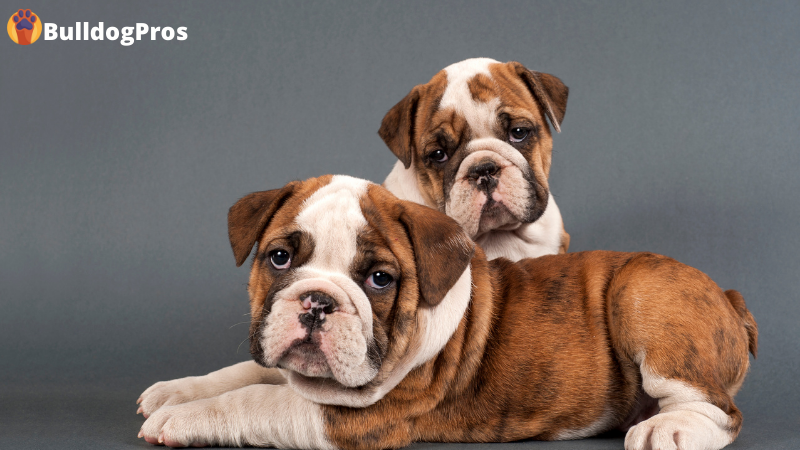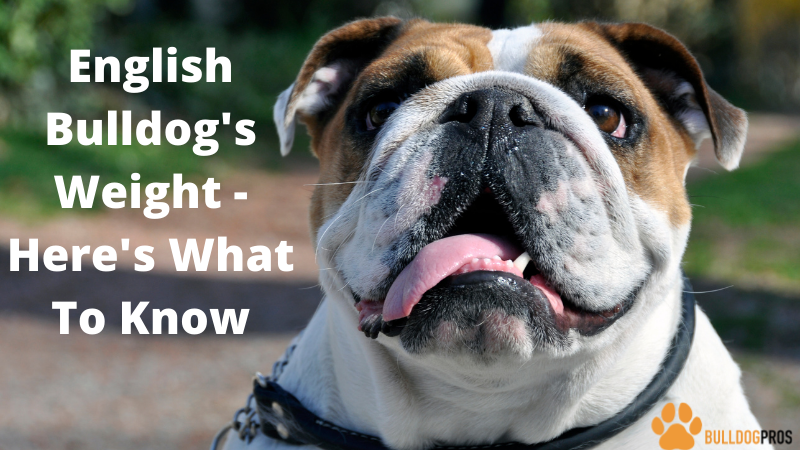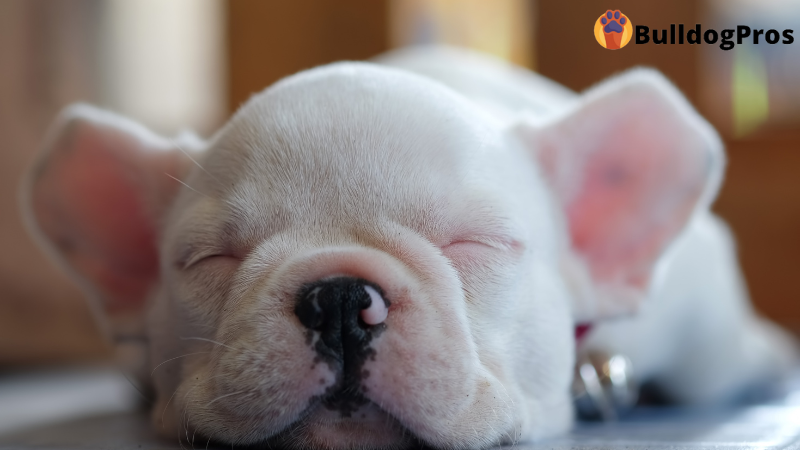From the time they are born to when they reach adulthood, Bulldogs go through a lot of growth during their lifetime. This blog English Bulldog Puppies: Stages of Growth With Growth Chart, discusses the various stages of growth and how they impact the English Bulldog. By reading it, you’ll be able to better understand and care for your English Bulldog puppy during their developmental period.
The transformation from puppies to adults can be amazing. Each Bulldog will develop differently and go through many stages throughout the first few years. While some will grow faster than others, many take up to 2 or more years to complete the stages of growth.
However, to generalize what you can expect with your Bulldog puppy, we have put together a chart of the most common stages. Please remember that diet, exercise, and supplements are very important throughout your Bulldog’s life and can have a significant impact on the proper growth and development in the first few years.
English Bulldog Growth Chart For Puppies
| Age | Average English Bulldog Weight | Features |
| Newborn | .5 – 1 lb | Flat, Wrinkly Face |
| 3 to 5 Weeks | 6.5 lbs | May Begin to Stand and Walk |
| 5 to 8 Weeks | 6.5 – 11 lbs | Skin and Winkles Really Begin To Develop |
| 9 to 12 Weeks | 15 lbs | Growth Spurt. Legs Look Long and Thin |
| 3 to 7 Months | 15 – 41.5 lbs | Putting on Weight. Head Looks To Small For Their Body |
| 7 to 12 Months | 41.5 – 50.5 lbs | Another Growth Spurt Where Legs Look Long And Thin |
| 12 to 18 Months | 50.5 lbs | The Frame of Puppy Is At Maturity. Grow In Width |
Video: English Bulldog Puppies: Stages Of Growth
Newborns
- From birth to 3 weeks, English Bulldog puppies typically resemble adorable rodents with flat, wrinkly faces. The body wrinkles may be visible on their legs, and the skin may seem a bit baggy on their body, but it is still challenging to determine the actual build of the puppy.
- The newborn pup doesn’t have eyesight yet and will rely on their hearing to keep track of mom and their litter mates.
- Usually, around 2 – 4 weeks, baby teeth are starting to develop but won’t be completed for a few more weeks.
3 to 5 Weeks
- Puppies begin to take shape at three weeks of age, developing skin on their faces and increasingly on their bodies. Their builds become a bit more apparent as they begin to stand and walk, giving you a glimpse of their stance.
- The nervous system is rapidly developing at this time, and vision is also beginning to grow.
- It’s around four weeks of age that Bulldogs typically become more alert and start playing with other dogs during playtime.
- Interaction matters, even at this young age. This sets the stage for how well they will bond.
5 to 8 Weeks
- They begin to look more like ‘puppies’ at around five weeks. Their builds become more apparent, and the skin and wrinkles really begin to develop.
- Baby teeth are usually all in around 5-6 weeks. This is when many pups will go through the finger-chewing puppy stage.
- They eat more every day as they go through various stages of digestion in preparation for the first solid food introduction around this time.
- They begin to fill out as they transition from milk to dry food and complete the weaning process.
- At about 8 weeks, your puppy has just started getting used to sleeping through the night.
9 to 12 Weeks
- One of the significant growth spurts typically begins after puppies arrive home at 8 to 9 weeks. You may notice that their legs look a bit long and thin. This is because their legs are generally the first area of growth in preparation for the weight they will maintain throughout their lives.
- Your puppy is ready for adventure and has a great passion for exploring and playing with toys and their littermates.
- You can begin training your puppy at the latter part of this age. Remember, he/she is only a puppy, and lots of patience and positive reinforcement are needed.
- Get ready, for he/she will soon begin to show signs of independence.
3 to 7 Months
- At three months of age, they begin to put on more weight, and the skin on their body will increase. With this, their heads may appear too small for their bodies, which is perfectly normal and usually only lasts a few months.
- As a 16 week old English Bulldog, your pup is entering adolescence. Hold on for this. You might see chewing, not listening, and barking.
- You will see a resurgence of teething as the puppy teeth fall out and the adult set comes in. Much like humans, this can cause pain and irritation as the teeth push through the gums. Have plenty of chew toys around, so if they are chewing on something they shouldn’t (shoes, furniture, etc.), you can divert the behavior to a chew toy.
7 to 12 Months
- Just about the time everything starts to come together at six months, the next growth spurt begins. Here again, you may see that their legs appear long and skinny for a month or two, and the entire process starts again.
- Adolescence is at its peak, around seven months. You may see an increase in rebelliousness, stubbornness, and not listening. Remember, it’s easy to become frustrated but stay calm and continue with positive reinforcement.
12 to 18 Months
- The frame of your puppy should now be at maturity. You should not see any increase in height or length, but now they will begin to grow in width as they ‘finish out’ to maturity.
- For the most part, puppyhood has completed its course.
The stages of growth for your English bulldog above are all estimates. Your Bulldog might be above or below the information above, but that’s completely normal.
Make sure you check in with your veterinarian to check up on your Bulldog and get recommendations on what to eat, exercise, and other recommendations for your Bulldog’s health.
English Bulldog Puppy Growth Factors
Just like humans, every English Bulldog is different. As they develop and grow, you’ll start seeing differences in your own Bulldog’s growth compared to others.
Genetics
Knowing your Bulldog’s family history is going to assist in predicting whether or not your Bulldog has any genetic ailments coming from their parents.
There are certain ailments that are common in the English Bulldog. In fact, because of drastic changes in appearance over the years, they are susceptible to a large number of diseases and more than many other dog breeds.
Three genetically prominent ailments in the English Bulldog are hip dysplasia, patellar luxation, and hypothyroidism, which can all affect your dog’s development throughout the years.
Nutrition
Following a proper diet can play a big role in your Bulldog’s health. Feeding them nutritious food will help keep them within the target weight appropriate for their age.
Proper nutrition is vital for your dog’s development throughout its life. A veterinarian will be great at recommending different diets and brands of food that can help your Bulldog’s development and manage their weight.
Physical Activity & Health
Exercise is just as important as a healthy diet. The English Bulldog is a short stature dog breed, so you’ll want to keep vigilant of how much exercising they’re doing.
This plays a part when it comes to maintaining that healthy weight range. Getting your dog out for a walk also gets you out and active as well!
Spaying And Neutering
Weight gain and lethargy are common worries following either surgery, but a causal link has not been found between the two.
Many times the surgery takes place when the puppy is in the midst of rapid development and growth, so the weight gain could simply be caused by normal development.
However, consider consulting your veterinarian about any worries or questions you might have.
Read Next: What Is An Olde English Bulldogge: History, Temperament, & Care
What If My English Bulldog Is Not The Right Weight
While they develop, your Bulldog may be over or under the weight range for their age at different stages.
If you notice just a pound or two, there’s no need for alarm. But if you notice a significant difference, you should talk with a veterinarian about some factors that could affect your Bulldog’s development.
A male English Bulldog typically weighs more than a female English Bulldog so expect this discrepancy.
If they’re overweight, try adding more exercise and readjusting their diet. Having your Bulldog get overweight can lead to hip dysplasia, cancer, osteoarthritis, high blood pressure, liver disease, diabetes, or even heatstroke.
But before taking any action, it’s recommended to discover changes with your Bulldog’s veterinarian.
Questions About English Bulldog Puppies: Here Are Your Answers
When Do Bulldogs Stop Growing?

By the time they turn one, most English bulldogs will stop growing. However, you’ll still see them filling out in their chest and adding weight until they are about two years old. However, most of their growth and development has taken place during their first year of life.
Are English Bulldogs good pets?
English Bulldogs are wonderful pets to have as they are loyal and a great conversation starter.
At what age do English Bulldogs start walking?
Around week 4, English Bulldogs start to walk. Of course, they do stumble around a bit as they’re trying to get their legs stronger.

Share this Image On Your Site
Related Articles
You Might Also Be Interested In Reading: How To Potty Train An English Bulldog Puppy
Take Away
English Bulldogs are one of the most popular dog breeds in the world because they offer so much love. English Bulldog Puppies: Stages Of Growth With Growth Chart discussed their stages of growth and maturity, from birth to adulthood. If you find your dog isn’t developing as it should, be sure to get a veterinarian’s recommendations.
Do you have a growing English Bulldog puppy at home? Share your experience in the comments below!



